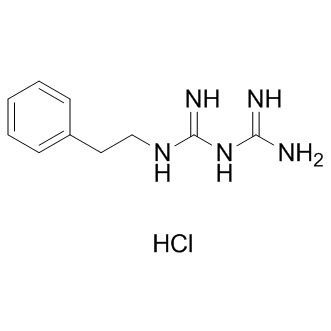| Cas No.: | 834-28-6 |
| SMILES: | Cl.NC(NC(NCCC1=CC=CC=C1)=N)=N |
| Formula: | C10H16ClN5 |
| M.Wt: | 241.72 |
| Purity: | >98% |
| Sotrage: | 2 years -20°C Powder, 2 weeks 4°C in DMSO, 6 months -80°C in DMSO |
| Description: | Phenformin, an anti-diabetic drug, has demonstrated antitumor activity both in vitro and in vivo.in vitro: Treatment with phenformin significantly delayed the development of resistance to PLX4720 in cultured melanoma cells. Biochemical analyses showed that phenformin and PLX4720 exerted cooperative effects on inhibiting mTOR signaling and inducing apoptosis. Noticeably, phenformin selectively targeted subpopulations of cells expressing JARID1B, a marker for slow cycling melanoma cells, whereas PLX4720 selectively targeted JARID1B-negative cells. Phenformin also exhibited histone modification and was more effective than metformin in destabilizing MYC/MYCN in NB cells. Phenformin activates UPR sensors IRE1α and pancreatic endoplasmic reticulum kinase (PERK) in both an ER-dependent and ER-independent manner. Mechanistically, AMP-activated protein kinase (AMPK) activation is required but not sufficient to initiate phenformin-mediated IRE1α and PERK activation, suggesting the involvement of additional factor(s). in vivo: The chronic treatment of female C3H/Sn mice with phenformin (2 mg/day) and diphenylhydantoin (2 mg/day) prolonged mean life span by 23 and 25%, respectively, and decreased spontaneous tumour incidence by 4.0 and 2.3 times, respectively. Oral administration of 5--10 mg of an antidiabetic biguanide-phenformin (phenethyl-biguanide) for 2.5--5 months suppressed DMBA-induced mammary tumour development in rats considerably. Phenformin-treated rats revealed-a tendency towards a decrease in blood insulin level (radioimmunoassay). |

 DC Chemicals' products qualify for U.S. tariff exemptions. We guarantee no price increases due to customs duties and maintain stable supply, continuing to deliver reliable research solutions to our American clients.
DC Chemicals' products qualify for U.S. tariff exemptions. We guarantee no price increases due to customs duties and maintain stable supply, continuing to deliver reliable research solutions to our American clients.





















